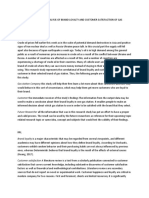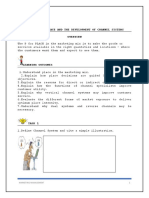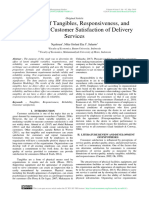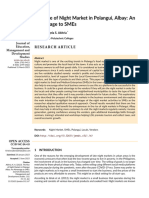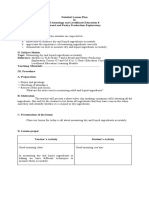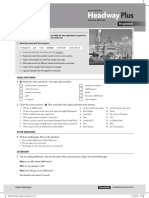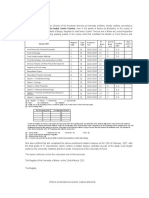Practical Research 1 - Group 1
Uploaded by
Mack Jigo DiazPractical Research 1 - Group 1
Uploaded by
Mack Jigo DiazChapter I
Theoretical Framework
This study was anchored on the following theories:
The Dissonance Theory
The Dissonance Theory suggests that a person who expected a high-value product and
received a low-value product would recognize the disparity and experience a cognitive
dissonance (Cardozzo, 1965). That is, the disconfirmed expectations create a state of dissonance
or a psychological discomfort (Yi, 1990). According to this theory, the existence of dissonance
produces pressures for its reduction, which could be achieved by adjusting the perceived
disparity. This theory holds that “post exposure ratings are primarily a function of the
expectation level because the task of recognizing disconfirmation is believed to be
psychologically uncomfortable. Thus consumers are posited to perceptually distort expectation-
discrepant performance so as to coincide with their prior expectation level” (Oliver, 1977, p.
480). For instance, if a disparity exists between product expectations and product performance,
consumers may have a psychological tension and try to reduce it by changing their perception of
the product (Yi, 1990). Cardozzo argues that consumers may raise their evaluations of those
products when the cost of that product to the individual is high. For example, suppose that a
customer goes into a restaurant, which she or he expects it to be good, and is confronted with an
unappetizing meal. The consumer, who had driven a long distance and paid a high price for the
meal, in order to reduce the dissonance, might say that the food was not really as bad as it
appeared or she likes overcooked meal, etc.
Assimilation Theory
Assimilation theory is based on Festinger’s (1957) dissonance theory. Dissonance theory
posits that consumers make some kind of cognitive comparison between expectations about the
product and the perceived product performance. This view of the consumer post-usage
evaluation was introduced into the satisfaction literature in the form of assimilation theory.
According to Anderson (1973), consumers seek to avoid dissonance by adjusting perceptions
about a given product to bring it more in line with expectations. Consumers can also reduce the
tension resulting from a discrepancy between expectations and product performance either by
distorting expectations so that they coincide with perceived product performance or by raising
the level of satisfaction by minimizing the relative importance of the disconfirmation
experienced.
Contrast Theory
Contrast theory was first introduced by Hovland, Harvey and Sherif (1987). Dawes et al
(1972) define contrast theory as the tendency to magnify the discrepancy between one’s own
attitudes and the attitudes represented by opinion statements. Contrast theory presents an
alternative view of the consumer post-usage evaluation process than was presented in
assimilation theory in that post-usage evaluations lead to results in opposite predictions for the
effects of expectations on satisfaction. While assimilation theory posits that consumers will seek
to minimize the discrepancy between expectation and performance, contrast theory holds that a
surprise effect occurs leading to the discrepancy being magnified or exaggerated. According to
the contrast theory, any discrepancy of experience from expectations will be exaggerated in the
direction of discrepancy. If the firm raises expectations in his advertising, and then a customer’s
experience is only slightly less than that promised, the product/service would be rejected as
totally un-satisfactory. Conversely, under-promising in advertising and over-delivering will
cause positive disconfirmation also to be exaggerated
The Expectancy Disconfirmation Paradigm
Drawing on the shortcomings of the above early theories of consumer satisfaction, Oliver
(1977; 1980) proposed the Expectancy-Disconfirmation Paradigm (EDP) as the most promising
theoretical framework for the assessment of customer satisfaction. The model implies that
consumers purchase goods and services with pre-purchase expectations about the anticipated
performance. The expectation level then becomes a standard against which the product is judged.
That is, once the product or service has been used, outcomes are compared against expectations.
If the outcome matches the expectation confirmation occurs. Disconfirmation occurs where there
is a difference between expectations and outcomes. A customer is either satisfied or dissatisfied
as a result of positive or negative difference between expectations and perceptions. Thus, when
service performance is better than what the customer had initially expected, there is a positive
disconfirmation between expectations and performance which results in satisfaction, while when
service performance is as expected, there is a confirmation between expectations and perceptions
which results in satisfaction. In contrast, when service performance is not as good as what the
customer expected, there is a negative disconfirmation between expectations and perceptions
which causes dissatisfaction.
This type of discrepancy theory has a long history in the satisfaction literature dating back
at least to Howard’s & Sheth’s (1967) definition of satisfaction which states that it is a function
of the degree of congruency between aspirations and perceived reality of experiences. Porter
(1961) can be credited with early empirical applications of this comparative model of customer
satisfaction in the field of job satisfaction (cf. Oliver, 1997). In his study, Porter, for instance,
compared the worker’s perception of how much of a job facet (for example, pay) there should be
to the worker’s perception of how much is the facet there now. In support of Porter’s view,
Locke (1965) proposed that this discrepancy methodology could be employed in assessing
employees’ job satisfaction
The Importance- Performance Model
Although the EDP has dominated as the theoretical construct with which to measure
satisfaction and that predictive expectations are regarded as the comparison standard that best
explains satisfaction, the impact of attribute importance is also recognized (Barsky, 1992;
Martilla and James, 1977; Oh & Parks, 1997). Satisfaction is seen as a function of customer
perceptions of performance and the importance of that attribute. Based on the expectancy-value
model, developed by Fishbein and Ajzen (1975), in which attribute importance and beliefs play a
central role, Barsky (1992) posited that overall satisfaction/dissatisfaction toward a
product/service are dictated by the importance of specific characteristics and the degree to which
that product provides the specific characteristics. This model predicts that people generally have
a belief about an attribute, but each attribute may be assigned important weighting relative to
other attributes (ibid.). This implies that customers’ satisfaction levels are related to the strength
of their beliefs regarding attribute importance multiplied by how well these attributes meet their
expectations (Barsky, 1992) (a modified version of EDP to measure customer satisfaction).
The Value Percept Theory
Similar to LaTour and Peat’s argument, Westbrook and Reilly (1983) argue that the
Expectancy-Disconfirmation paradigm may not be the most appropriate model to explain
customer satisfaction, as customer satisfaction/dissatisfaction is more likely to be determined by
comparative standards other than expectations. They proposed a Value-Percept Disparity theory,
originally formulated by Locke (1967), as an alternative to the Expectation-Disconfirmation
paradigm. Criticizing the predictive expectations used as a comparison standard in the traditional
Disconfirmation paradigm, Westbrook and Reilly argue that what is expected from a product
may or may not correspond to what is desired or valued in a product. Conversely, that which is
valued may or may not correspond to what is expected. Thus, values have been proposed to be a
better comparative standard as opposed to expectations in explaining customer
satisfaction/dissatisfaction. According to the value-percept theory, satisfaction is an emotional
response that is triggered by a cognitive evaluative process in which the perceptions of an offer
are compared to one’s values, needs, wants or desires (Westbrook & Reilly, 1983). Similar to the
Expectancy/Disconfirmation paradigm, a growing disparity between one’s perceptions and one’s
values (value-perception) indicates an increasing level of dissatisfaction.
Conceptual Framework
Figure 1
Schematic Diagram of the Assessment of the Customers Satisfaction Level in Selected Fast
Food Chain in Maasin City Proper
Assessment of the Customers Satisfaction
Level in Selected Fast Food Chain within
Maasin City
Profile Factors
Sex Service
Age Quality of Product
Strand of a student Perceived Value
Cleanliness
Process
Gathering of data and information through distribution of survey
questionnaires.
Checklists to the customers of the selected fast food chain.
Data are interpreted and analyzed.
In this view of the literature, Figure 1 shows the Assessment of the Customers
Satisfaction Level to the Selected Fast Food Chain in Maasin City.
Output
Customer Satisfaction level to the Selected Fast Food
The conceptual framework of the study consists of the profile of the respondents which
includes; sex, age, and strand of a student. It also shows the different factors influencing fast
food chains which includes; service, quality of product, perceived value and cleanliness.
On the other hand, the data process of this research was through the distribution of
questionnaires followed by interpretation and analyzing of the data or gathered information. The
output of this study was to determine the factors influencing fast food chain business to its
extent.
DEFINITION OF TERMS:
The following terms was operationally defined:
Ambiance
Look and feel of a place (mall, restaurant, tourist destination, etc.) that evokes a unique
atmosphere or mood and makes it ‘sticky’ (compels people to come and stay around).
Cleanliness
The quality or state of being clean : the practice of keeping oneself or one’s surroundings
clean
Fast Food
Designating or of a type of restaurant specializing in low-cost carryout food (fast food)
that is prepared and served quickly
Food quality
Refers to the features and characteristics of a food product that is: acceptable to consumers
and meet their expectations; value for money; conforms to the required specifications, and
profitable to the company.
Perceived value
A customer’s opinion of a product’s value to him or her. It may have little or nothing to do
with the product’s market price, and depends on the product’s ability to satisfy his or her needs
or requirements.
Price
A value that will purchase a finite quantity, weight, or other measure of a good or service.
As the consideration given in exchange for transfer of ownership, price forms the essential basis
of commercial transactions.
Satisfaction
Customer level of approval when comparing a product’s perceived performance with his
or her expectations. Also could refer to discharge, extinguishment, or retirement of an obligation
to the acceptance of the obligor, or fulfillment of a claim.
Service
A valuable action, deed, or effort performed to satisfy a need or to fulfill a demand.
CHAPTER II
REVIEW OF RELATED LITERATURE AND STUDIES
Fast Food is usually referred to a hamburgers, pizza, chicken or fries or the kind of food
that can be prepared and served quickly at low price. Since 1950’s, fast food was penetrating the
food market and becoming more and more popular. It is common to see a long line in a drive-
through way outside of a fast food restaurant or a bunch of crowded clients waiting in order in
front of a fast food outlets. Fast food culture is vigorously uprising trend among the youngster
(Jaya Shanker Kaushik 2011). Although, its impact exist on whole society, whether belong to
lower middle class and/or elite class. But beside this thing till today there is no proper definition
of the fast food. According to leading websites, fast food is the tern given to food can be
prepared and serve very quickly (Habid et al. 2011) described fast food as quickly prepared,
reasonably priced and readily available alternatives to home cooked food.
36.6 percent of adults – about 85 million – consumed fast food, including pizza, on a
given day. The percentage was higher for people between the ages of 20 and 39 (44.9 percent)
and 40 and 59 (37.7 percent). Those 60 and older were least likely to consume fast food, at 24.1
percent in the US according to National Health and Nutrition Examination Survey while 54
percent of Filipino eat at a fast food restaurant at least once a week according to A.C, Nielsen.
Two age groups that appear to have undergone the most dramatic changes in eating habits over
recent decades are adolescents aged 12 to 18 years, and young adults aged 19 to 29 years
(Nielsen SJ, Siega-Riz AM, Popkin BM).
Building customer satisfaction is considered to be a key priority for business success.
Therefore, determining the factors that affect customer satisfaction is important including the
food quality, price fairness and physical environment on customer satisfaction in fast food
restaurant. Service quality, food quality and perceived value are all significant antecedents of
customer satisfaction in the fast food, food quality has a significant positive effect on customer
satisfaction and price fairness and physical environment have significant positive effects on
customer satisfaction. These findings provide useful suggestions and guidelines for the policy
makers in fast food restaurant industry and confirm the importance of the selected factors in
affecting customer satisfaction (Jalal Hanaysha, 2016).
Customer satisfaction is a term frequently discussed in marketing because it is normally
used as a key performance indicator of many businesses. It is a measure of how products and
services supplied by a company meet or exceed customer expectation. Customer satisfaction
along with customer loyalty is becoming a paramount factor in the businesses for their
long-term and short-term survival. According to Gronholdtet et al.,(2000), customer
expectation is the base for customer satisfaction. When performance of any organization
meets or exceeds the expectation, customers will be satisfied and they are likely to do
repurchase and recommend the product to others. Accordingly, Engel et al., (1990) satisfaction
is defined as the outcome of the subjective evaluation that the chosen alternative meets or
exceeds expectations. Kotler et al., (2013), defined customer satisfaction as a persons feeling
of pressure or disappointment that result from comparing a products perceived performance
or outcome to the expectation.
According to Zairi (2000) the feeling of pleasure and expectation fulfillment is known as
Satisfaction. If the product will not satisfied customer feelings they will be dissatisfied, and if
product satisfied them after the use customer will be satisfied and become loyal to that product or
brand. In other words customer satisfaction is goods or service which fulfil the customer
expectation in terms of quality and service for which he paid. If Customer Satisfaction develops
they will become loyal to that product or brand and their loyalty will be good for the company in
sense as a profit.
Lim (2010) Customer’s ultimate satisfaction may have significant affect of atmosphere .
Physical surroundings are helpful to create image in the mind of customer and to influence their
behavior. Physical atmosphere of the restaurants have the significant impacts on the customers
satisfaction. Lightning, furnishing, sent, music and different other atmospheric factors among
them influence on customer satisfaction.
Skindaras (2009) there are millions of products in this world having different prices.
Pricing a product is difficult thing to do. Prices are set according to the value of the product.
Price from marketing mix Han (2009) state that one of the most flexible element that changed
quickly. In the literature of Khan (2011) marketing the most important factor indicated for
customer satisfaction is price, because most of the customers estimate the value of the product or
obtained service through price.
Lim (2010) for the customer it is not necessary that a better quality can be a better taste,
if customer like the taste of food he/she will be willing to pay for the it. Based on previous
researches, in customer satisfaction and taste, there is a significant correlation found between
them. Researchers found that Good taste of food has positive influence on customer’s
satisfaction and it also increase the customer’s retention rate which is also depends upon
customer’s satisfaction. Therefore, restaurants focus is on taste of the food and services that has
influence on customer’s satisfaction.
In today's ever‐increasing globalization of services and brands, service‐oriented
businesses need to attend to the satisfaction of their customers both domestically and abroad
while transcending unique cultural differences from country to country. It is based on data
collected from customers of five globally‐franchised fast‐food chains, using a previously
developed service satisfaction instrument. The study reveals two empirically derived, cross‐
cultural fast‐food customer satisfaction dimensions: satisfaction with the personal service and
satisfaction with the service setting. Should future research support this study's findings, the
measurement of cross‐cultural service satisfaction among franchised brands and services could
aid business managers’ efforts to assess the quality of the services they provide across national
boundaries and on a more real time, practical basis (G Ronald Gilbert, Cleopatra Veloutsou,
Mark MH Goode, Luiz Moutinho).
Fast food industry is highly competitive to stand out in this crowded field where
understanding consumer behavior is a must. To be successful, it must be able to project the right
image of quality to the customers and ensure that they will continue patronizing the business
(Mabel O Lopez, 2018). Quality of Service, Pricing, Ambiance and Quality of Food which are
considered as independent. Age and Gender are part of Demographics. According to the IBIS
World report on “Industry Market Research Report 2018”, the Global Food Industry has grown
over the period of five years despite the change in factors such as consumer tastes and a
recovering global economy. With the increase in disposable income the spending increased by
the consumers on luxuries such as dinning out. In result of this the fast food operators started to
gain benefits by providing full-service restaurants (Mahnoor Farooqui, S Khuram Khan Alwi)
According to Andrea K Garber, Robert H Lustig 2011, fast food falls squarely into that
category, it has several other attributes that may increase its salience. This review examines
whether the nutrients present in fast food, the characteristics of fast food consumers or the
presentation and packaging of fast food may encourage substance dependence, as defined by the
American Psychiatric Association. The majority of fast food meals are accompanied by a soda,
which increases the sugar content 10-fold. Sugar addiction, including tolerance and withdrawal,
has been demonstrated in rodents but not humans. Limited evidence suggests that the high fat
and salt content of fast food may increase addictive potential. Fast food restaurants cluster in
poorer neighborhoods and obese adults eat more fast food than those who are normal weight.
Finally, fast food advertisements, restaurants and menus all provide environmental cues that may
trigger addictive overeating. While the concept of fast food addiction remains to be proven, these
findings support the role of fast food as a potentially addictive substance that is most likely to
create dependence in vulnerable populations.
Many attribute the rise in obesity since the early 1980s to the overconsumption of fast
food. A dynamic model of a differentiated-product industry equilibrium shows that a firm with
market power will price below marginal cost in a steady-state equilibrium. A spatial hedonic
pricing model is used to test whether fast food firms set prices in order to exploit their inherent
addictiveness. The results show that firms price products dense in addictive nutrients below
marginal cost, but price products high in nonaddictive nutrients higher than would be the case in
perfect competition (Timothy J Richards, Paul M Patterson, Stephen F Hamilton, 2011)
CHAPTER III
RESEARCH METHOLOGY
Research Design
This study will use the quantitative type of research specifically the descriptive design.
Descriptive Design will be use to seek to determine the profile of the respondents in terms of
their name, sex, strand and section. By the reason the researchers will use descriptive design
because it implement and describe on how customers satisfy to the level of service cognize by
customers to the selected fast food.
Research Respondents/Participants
The research respondents will be the selected Grade 11 students of Saint Joseph College,
Maasin City. The 30 students from ABM and 20 students for STEM a total of 50 students to
serve as the participants of the study. The selection of the respondents will use non-probability
sampling more specifically the purposive sampling method to gathered data were researchers
choose only those people who they deem fit to participate in the research study and does not give
all the individuals in the population an equal chance of being selected.
Research Environment/Locale
The study will be conducted in 11 ABM students in SJC where the researchers are
assigned to know what kind of feedback can SJC student tell to all fast-food chains in Maasin,
this place was selected for knowing the efficiency of the fast foods and the respondent’s
satisfaction. The fast-food chain areas where the researcher wants to collect their respondents
feedback are Jollibee, Andok's and May Abohan. The geographical location is presented in
figure 2.
Figure 2
Research Instrument
This study will use a constructed questionnaire and checklist. The questions include were
the demographic background of the respondents such as name, age, strand and section. The level
of management as perceived by the customers in terms of service quality, food quality, perceived
value, ambiance and cleanliness are also included in the checklist. A cover letter was attached to
each questionnaire for authorization and assurances of confidentiality of answers.
Data Collection procedure
Before the researcher administered the questionnaires, a letter requesting for permission
was submitted to the principal and instructor to the respondents to avoid misunderstanding in
both parties. Upon the approval, the researchers with the letter of request was administered the,
the interaction started between the researchers and the respondents. The retrieval and tally of
data is immediately conducted and impose after the respondents finish answering the
questionnaires and checklist.
Data Analysis
DETERMINING THE PERCENT SHARE OF AN ITEM (R)
f
R= ( n ) 100
Where:
f- frequency of an item
n- total number of observations
DETERMNING THE WEIGHTED MEAN (WM)
WM = ∑ fw
❑
n
Where:
f- frequency
w- weighted score
n- sample size
DETERMINING THE SIGNIFICANT DIFFERENCES
Z- test:
2
( n1 and n2 ≥ 30; σ are unknown)
2
Z = x1 - x2
√ s 12 + √ s 12
n1 n2
Where:
x 1 – Sample mean of the first group
x 2 – Sample mean of the second group
S 12- Sample mean of the first group
You might also like
- The Cancer-Fighting Kitchen by Rebecca Katz - Recipes and Excerpt80% (10)The Cancer-Fighting Kitchen by Rebecca Katz - Recipes and Excerpt21 pages
- Correlational Analysis of Brand Loyalty and Customer Satisfaction of Gas Station in Bacoor CityNo ratings yetCorrelational Analysis of Brand Loyalty and Customer Satisfaction of Gas Station in Bacoor City2 pages
- Final MR Manuscript PintucanValeros Chapter1-5No ratings yetFinal MR Manuscript PintucanValeros Chapter1-547 pages
- Tourism and Hospitality Marketing Reviewer-1No ratings yetTourism and Hospitality Marketing Reviewer-16 pages
- Technology Utilization in The Hotel Industry: Challenges and ProspectsNo ratings yetTechnology Utilization in The Hotel Industry: Challenges and Prospects17 pages
- Thc2: Risk Management As Applied To Safety, Sanitation and Security Bshm-INo ratings yetThc2: Risk Management As Applied To Safety, Sanitation and Security Bshm-I5 pages
- Service Quality and Customer Satisfaction Among Selected Bakeshop in Panabo CityNo ratings yetService Quality and Customer Satisfaction Among Selected Bakeshop in Panabo City65 pages
- Level of Customer Satisfaction On Customer Service and Food Quality100% (1)Level of Customer Satisfaction On Customer Service and Food Quality11 pages
- Group 4 Mallberry Suites Business Hotel MicroNo ratings yetGroup 4 Mallberry Suites Business Hotel Micro8 pages
- Assessment On Service Quality of A Fast Food Restaurant at Mcdonalds in Cebu CityNo ratings yetAssessment On Service Quality of A Fast Food Restaurant at Mcdonalds in Cebu City8 pages
- Perception of The Custumer Toward To The Food Restaurant To Be Built in Boac MarinduqueNo ratings yetPerception of The Custumer Toward To The Food Restaurant To Be Built in Boac Marinduque18 pages
- Theoretical-Framework (Food Safety and Sanitation)No ratings yetTheoretical-Framework (Food Safety and Sanitation)3 pages
- Factors Influencing Consumption Demand in Fast Food Restaurants Among The Students of Institute of Hospitality and Tourism Management in Baliwag Polytechnic College 1No ratings yetFactors Influencing Consumption Demand in Fast Food Restaurants Among The Students of Institute of Hospitality and Tourism Management in Baliwag Polytechnic College 157 pages
- The Effect of Tangibles, Responsiveness, and Reliability On Customer Satisfaction of Delivery ServicesNo ratings yetThe Effect of Tangibles, Responsiveness, and Reliability On Customer Satisfaction of Delivery Services7 pages
- The Level of Customer Satisfaction With The Services of Green Cuisine, Poblacion, Banaybanay, Davao OrientalNo ratings yetThe Level of Customer Satisfaction With The Services of Green Cuisine, Poblacion, Banaybanay, Davao Oriental38 pages
- Dadiangas North High School: Republic of The PhilippinesNo ratings yetDadiangas North High School: Republic of The Philippines25 pages
- Food Safety Practices Among Vendors in Capaoay San Jacinto PangasinanNo ratings yetFood Safety Practices Among Vendors in Capaoay San Jacinto Pangasinan4 pages
- Students' Level of Satisfaction On The Program and Services Offered by The NEUST, San Isidro Campus100% (1)Students' Level of Satisfaction On The Program and Services Offered by The NEUST, San Isidro Campus9 pages
- Revised Consumer Perception On The Service Quality of Selected Roadside Cafeteria in Davao CityNo ratings yetRevised Consumer Perception On The Service Quality of Selected Roadside Cafeteria in Davao City15 pages
- Chapter 1 Understanding Hospitality FacilitiesNo ratings yetChapter 1 Understanding Hospitality Facilities3 pages
- Two Major Differences Between Service and Manufacturing OrganizationsNo ratings yetTwo Major Differences Between Service and Manufacturing Organizations2 pages
- Assessment of Customer Satisfaction On Home Based Catering Business in Cabadbaran CityNo ratings yetAssessment of Customer Satisfaction On Home Based Catering Business in Cabadbaran City7 pages
- Catering Service Inner Contents Fabella-EditedNo ratings yetCatering Service Inner Contents Fabella-Edited48 pages
- Abitria The Rise of Night Market in Polangui Albay An Advantage To SMEsNo ratings yetAbitria The Rise of Night Market in Polangui Albay An Advantage To SMEs11 pages
- Green Practices of Selected Restaurants in Solenad, Nuvali in Sta. Rosa Laguna, Philippines100% (1)Green Practices of Selected Restaurants in Solenad, Nuvali in Sta. Rosa Laguna, Philippines10 pages
- A Feasibility Study of Establishing Digital Marketing Services in General Santos City PDFNo ratings yetA Feasibility Study of Establishing Digital Marketing Services in General Santos City PDF10 pages
- Materials Costing: Kitchen Utensils Quantity Price TotalNo ratings yetMaterials Costing: Kitchen Utensils Quantity Price Total21 pages
- Get (Solution Manual) Advanced Macroeconomics 4th Edition by David Romer Free All Chapters100% (2)Get (Solution Manual) Advanced Macroeconomics 4th Edition by David Romer Free All Chapters34 pages
- Research Questions - Assignment 1 - Khushi - VyomNo ratings yetResearch Questions - Assignment 1 - Khushi - Vyom2 pages
- Transcultural Areas 1st Edition Dr. Wolfgang Berg (Auth.) - The ebook is now available, just one click to start reading100% (1)Transcultural Areas 1st Edition Dr. Wolfgang Berg (Auth.) - The ebook is now available, just one click to start reading52 pages
- Measuring Dry and Liquid Ingredients AccuratelyNo ratings yetMeasuring Dry and Liquid Ingredients Accurately4 pages
- 013 - 014 - Even If They Weren't So SweetNo ratings yet013 - 014 - Even If They Weren't So Sweet11 pages
- Teixeira and of Lurdes Magalhães: Xeira, Born in The Parish of Borba Da Montanha, in The County ofNo ratings yetTeixeira and of Lurdes Magalhães: Xeira, Born in The Parish of Borba Da Montanha, in The County of2 pages
- Reading and Writing Name:: Northstar Placement TestNo ratings yetReading and Writing Name:: Northstar Placement Test5 pages
- Food Service Procedures: By: Mumtazul IlyaniNo ratings yetFood Service Procedures: By: Mumtazul Ilyani27 pages



